| Origami Heaven A paperfolding
paradise
The website of
writer and paperfolding designer David Mitchell
x
|
| |
| Silverhexahedra |
| |
| Hexahedra
are solids which have six faces. In modular origami the
most commonly encountered hexahedral form, apart from the
cube, is the silverhexahedron, whose faces are all silver
or isosceles right angle triangles. |
| |
| Polyhedra |
| |
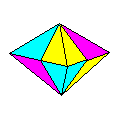 |
|
Name: The
Sonobe Hexahedron aka Toshie
Takahama's Jewel Modules / Paper
shape / Folding geometry: 3 modules from squares
using standard folding geometry.
Designer /
Date: First discovered by Mitsonobu Sonobe in the
1960s but popularised in the West in the early
1970s by Toshie Takahama who called it her
'jewel', (because it is possible to string
several together to form a necklace).
Diagrams:
On-line diagrams are available on the Modular Designs page of this site.
|
|
| |
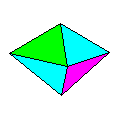 |
|
Name: The Corner-Pocket
Sonobe Hexahedron is essentially the
same design as the Sonobe Hexahedron but made
from corner-pocket Sonobe modules instead of
standard Sonobe modules. Modules / Paper
shape / Folding geometry: 3 modules from squares
using standard folding geometry.
Designer /
Date: Diagrams for the Corner-pocket Sonobe
module were first published in Origami for the
Connoisseur by Kunihiko Kasahara and Toshie
Takahama in Japanese in 1985 and in English in
1987, where it is called the Tomoko module.
Diagrams:
On-line diagrams are available on the Modular Designs page of this site.
|
|
| |
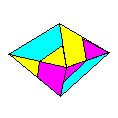 |
|
Name: The Letterbox
Hexahedron Modules / Paper
shape / Folding geometry: 3 modules from squares
using standard folding geometry.
Designer /
Date: David Mitchell, 1987.
Diagrams:
On-line diagrams are available on the Modular Designs page of this site.
|
|
| |
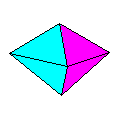 |
|
Name: The Sonobe
Delta Hexahedron can be made by
combining three Sonobe delta modules. Modules / Paper
shape / Folding geometry: 3 triangle modules from
squares using standard folding geometry.
Designer /
Date: David Mitchell,
Diagrams:
Not yet available.
|
|
| |
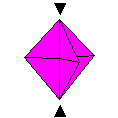 |
|
Name: Snap
Hexahedra - silverhexahedra made from
Sonobe, Corner-pocket Sonobe, Sonobe Delta or
Letterbox modules can be collapsed flat then
popped back into shape. Modules / Paper
shape / Folding geometry:
Designer /
Date: Larry Hart published a single-sheet design
for a snap hexahedron in the late 1980s. It seems
obvious that the same principle could be applied
to a modular hexahedron but I am not aware of
knowing about this before I came across the idea
while playing with snap silveroctahedra in 2015.
Diagrams:
Not yet available.
|
|
| |
 |
|
Name: Molly
Kahn's Hexahedron - an elegant and
clever design made from three delta modules. Many
decorative variants are possible. Modules / Paper
shape / Folding geometry: 3 triangle modules from
squares using standard folding geometry.
Designer /
Date: Molly Kahn, 1960s
Diagrams:
First published in the Origamian Vol 7 Issue 4 of
Winter 1967. Also found in Paul Jackson's Origami
Christmas Tree Decorations - British Origami
Society booklet 20 - 1982.
|
|
| |
 |
|
Name: The Zeta
Hexahedron Modules / Paper
shape / Folding geometry: 3 modules from squares
using standard folding geometry.
Designer /
Date: David Mitchell, 1990.
Diagrams:
In Building with Butterflies - David Mitchell -
Water Trade - ISBN 978-0-9534774-7-0.
|
|
| |
| Modular
Sculptures |
| |
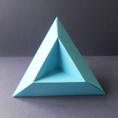 |
|
Name: Tricorne
- a distortion of the Zeta Hexahedron in which
both right angle corners are inverted to the
centre point. Modules / Paper shape / Folding
geometry: 3 modules from squares using standard
folding geometry.
Designer /
Date: David Mitchell, 1998.
Diagrams:
In Building with Butterflies - David Mitchell -
Water Trade - ISBN 978-0-9534774-7-0.
|
|
| |
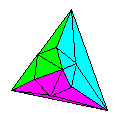 |
|
Name: Ariadne
3 Modules / Paper shape / Folding
geometry: 3 modules from squares using standard
folding geometry.
Designer /
Date: David Mitchell, 1990.
Diagrams:
Not yet available.
|
|
| |
| |






